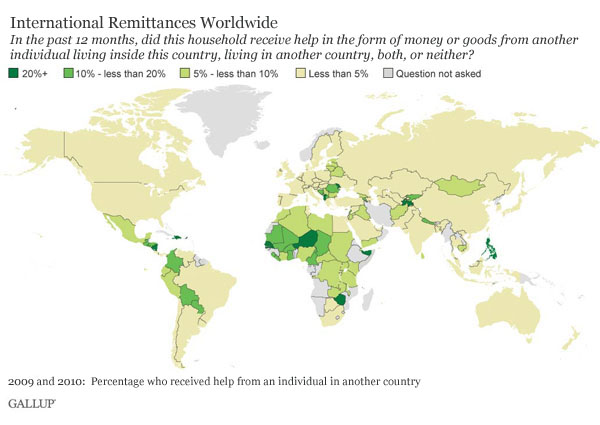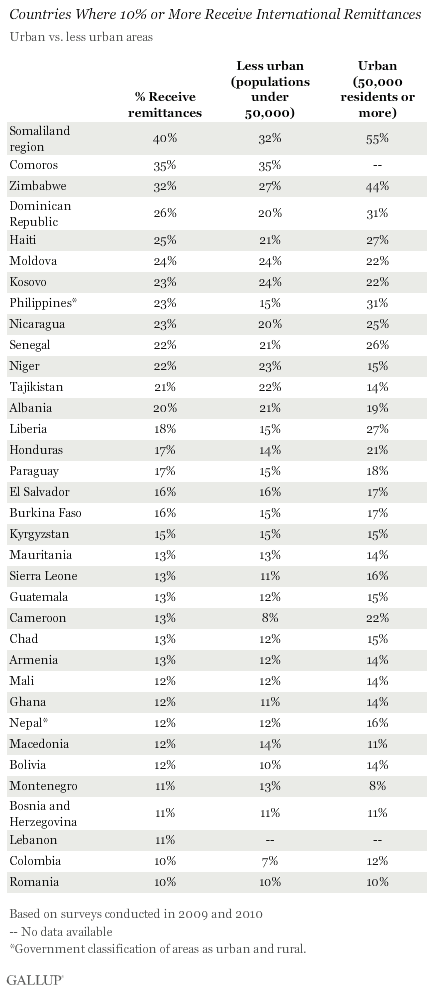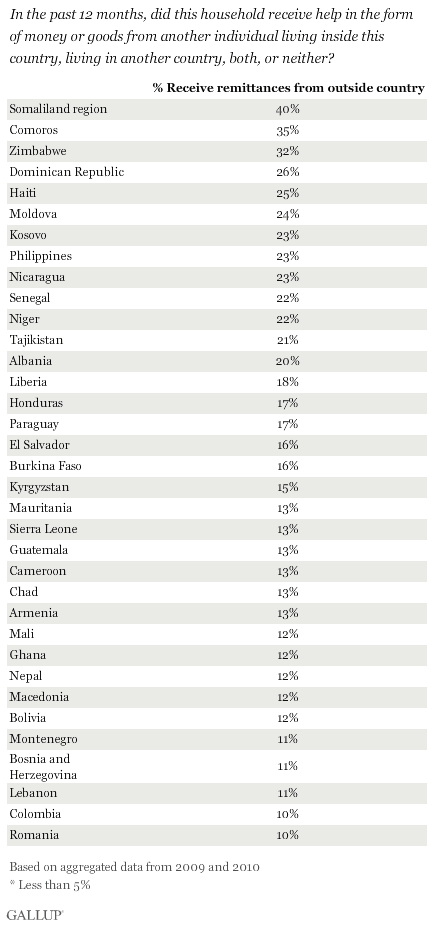WASHINGTON, D.C. -- Gallup surveys in 135 countries reveal about 3% of adults worldwide live in households that receive remittances -- either in the form of money or goods -- from someone in another country. In 35 countries, however, 10% or more report their households get this type of help. These countries are primarily concentrated in sub-Saharan Africa.

These results, based on aggregated data from surveys conducted in 2009 and 2010, capture information that complements officially recorded flows of money. Gallup's surveys ask about financial help in money or goods and are not restricted to transactions through formal channels. The data also shed additional light on remittances in countries -- particularly those in sub-Saharan Africa -- where little or no official data exist.
These findings may be conservative either because survey participants are reluctant to report getting help from someone or because the person randomly selected for the interview is unaware the household receives remittances.
Top Countries Receiving International Remittances
Adults in the Somaliland region, Comoros, and Zimbabwe are the most likely worldwide to report receiving remittances, with more than 30% of adults saying they get money or goods from someone in another country. These relatively high percentages likely reflect help from their large diasporas. In Zimbabwe, for example, where a quarter of the population lives outside the country, the Reserve Bank reports remittances increased 33% in 2010 to about $263 million.

Outside sub-Saharan Africa, the countries where the highest percentages of residents report receiving remittances are more spread out across Latin America, Central Asia, Eastern Europe, and Southeast Asia.
Where Remittances Go Varies by Country
Because Gallup's data track where recipients of remittances live, rather than where a formal remittance transaction ends, they provide insight about where remittances go.
In 12 of the 35 countries where 10% or more households report receiving help from abroad, residents in urban areas -- cities with 50,000 residents or more -- are more likely to report receiving international remittances than those in less urban areas -- towns and villages with populations less than 50,000. This is the case in Zimbabwe, Dominican Republic, the Philippines, and nine other countries.

The opposite is true in other countries such as Niger and Tajikistan, where residents of less urban areas are more likely to receive remittances than those in urban areas. In countries such as El Salvador and Kyrgyzstan, residents in urban and less urban areas are equally as likely to report receiving remittances. In many of these top-receiving countries -- but not all -- international remittances are reaching residents in less urban areas.
Bottom Line
Gallup surveys worldwide estimate how many adults live in households that receive financial assistance or goods from outside their own countries and where some of these remittances are going. The list of countries where high percentages report receiving this type of assistance is relatively small, but these remittances are likely a lifeline for millions of people. While international remittances often receive the lion's share of attention, they are only part of the story. Future articles will provide a worldwide picture of those receiving financial help from an individual within the same country.
For complete data sets or custom research from the more than 150 countries Gallup continually surveys, please contact SocialandEconomicAnalysis@gallup.com or call 202.715.3030.
Survey Methods
Results are based on face-to-face and telephone interviews conducted in 2009 and 2010 among residents aged 15 and older, in 135 countries. Data are aggregated. For most countries, sample size is 2,000 adults or greater. Four countries have sample sizes between 500 and 1,000: New Zealand, Latvia, Haiti, and Estonia. Data for Gulf Cooperation Council countries exclude non-Arab expatriates. For results based on the total sample in each country, one can say with 95% confidence that the maximum margin of sampling error ranges from ±1.0 percentage point in India to ±4.7 percentage points in Latvia and Estonia. The margin of error reflects the influence of data weighting. In addition to sampling error, question wording and practical difficulties in conducting surveys can introduce error or bias into the findings of public opinion polls.
For more complete methodology and specific survey dates, please review Gallup's Country Data Set details.


